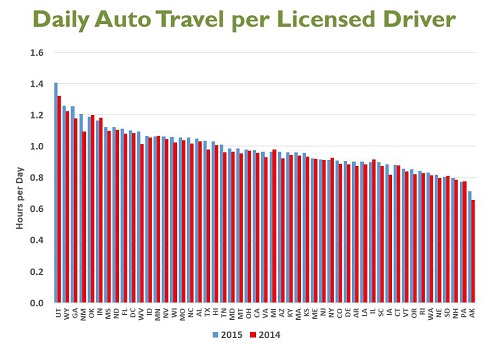How Much Time Do Americans Spend Behind the Wheel?
America’s roads exist to move people and goods quickly and efficiently. Assessing how the nation’s roads are performing in those most basic and critical functions requires the Federal Highway Administration (FHWA) to have reliable, comprehensive data.
Two of the most important measures for understanding road system performance are travel speed and travel time, according to U.S. DOT Volpe Center Chief Economist Don Pickrell, who spoke as part of The Ongoing Transformation of the Global Transportation System speaker series.
Pickrell and a team of Volpe Center data experts recently completed an in-depth study for FHWA and produced detailed statistics on travel speeds and vehicle hours traveled (VHT)—that can provide new levels of insight into how the nation’s roads are performing.
Across the country, American drivers spent more than 84 billion hours driving during 2015, according to this new data.
“We measure use of the nation’s highway system in excruciating detail, but we know much less about how the system is performing,” Pickrell said. “And so this project was an effort to develop a comprehensive measure of how well the U.S. highway system is performing.”
Watch video highlights from Volpe Center Chief Economist Don Pickrell's talk.
Overcoming Data Challenges
The data that the Volpe team used on travel speed and travel time come from two distinct sources that describe the same road systems. But the segments they use to describe to roadway system do not match between the sources—they contain information on different, sometimes overlapping road sections.
The Volpe team used geospatial methods to match the data from these two sources.
“That turns out to be quite a time-consuming and detailed process,” Pickrell said. “But we’ve ultimately succeeded in matching a high proportion of the two networks together.”

How Much Are Americans Driving Every Day?
Pickrell and his team sliced up the resulting VHT estimates in several different ways: by state and class of roadway, year-over-year changes, and detailed VHT results for specific road sections.
They examined the number of hours licensed drivers spend traveling each day across every state—perhaps a familiar data point for anyone who has ever been stuck in traffic on their way to work.
The Volpe team found that, on average, American drivers spend just under an hour driving every day, Pickrell said. Compare that to .96 hours per day average reported in in the 2009 National Household Travel Survey, and 1.1 hours per day reported in the American Time Use Survey.
“We think we’re in the right ballpark,” Pickrell said. “Those other surveys are both relatively small samples, whereas this is a comprehensive nationwide estimate.”

Applying VHT Data to Real-World Questions
The new VHT data will provide the basis for transportation experts to develop reliable estimates of road travel delays for metropolitan areas and nationwide. Because the VHT estimates are constructed from detailed spatial and temporal data, transportation professionals will also be able to distinguish between normal rush-hour delays and delays caused by incidents, road construction projects, special events, or abnormal weather.
“Of course, maybe the most obvious application is to monitor long-term trends in travel speed and time,” Pickrell said. “As I indicated previously, these are important measures of the way in which the highway system is performing.”
Finally, FHWA and Volpe are interested in how VHT data will shed light on the burden that road travel imposes on the time budgets of households and businesses.
“Time, when you think carefully about it, is the only truly non-renewable resource,” Pickrell said.
